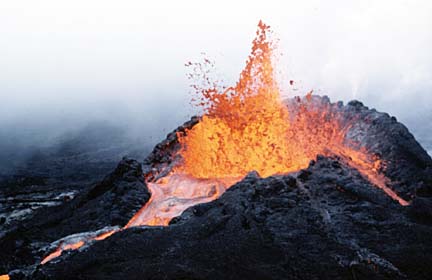

[ VOLCANO WATCH ]

Where does Kilauea erupt most often? Eruption frequency
similar over areasEruption update
U.S. Geological Survey
Hawaiian Volcano ObservatoryA visitor recently asked, "Does Kilauea erupt more often at the summit or along its two rift zones?" Let's try to answer that question.
The summit is a relatively small area, only about 4 miles across, including the caldera and its five pit craters: Halemaumau, Keanakakoi, the double crater of Kilauea Iki, and arguably Lua Manu.
Eruptions take place almost anywhere within this area.
In contrast, the southwest rift zone extends about 18 miles from the summit, and the east rift zone reaches out 75 miles -- 30 miles on land and 45 miles below sea level. Eruptions occur only along linear fissures, so the active part of each zone is long and narrow.
Eruptions along the rift zones tend to be larger than those at the summit, so the rift zones produce most of the lava erupted at Kilauea.
Eruptions are more concentrated at the summit than in any comparably sized area of the rift zones. That is the reason that the summit is the summit: It stands high because more lava flows have been erupted there.
One might think that more eruptions have taken place along the entire length of the rift zones than at the summit, because they are so long. It might take more eruptions to build a rift zone tens of miles long than it does to make the summit.
Can these ideas be substantiated by the past two centuries of eruptive activity?
During the 19th century, the summit had four or five eruptions, continuously in Halemaumau and briefly on Byron Ledge (1832, 1877) and in Kilauea Iki (1868). An eruption in Keanakakoi in 1877 could have been the same as the one on Byron Ledge.
Three or four flank eruptions took place during the same time: southwest rift zone (1823 and 1868), east rift zone (1840) and a questionable brief submarine event along the lower east rift zone (1884).
The number of eruptions, then, was about the same at the summit and on the flank. The total volume erupted on the flank is much larger, however -- a little more than 200 million cubic yards compared with less than 10 million cubic yards at the summit. During the 20th century, the summit erupted 22 times: 14 times in Halemaumau, once in Kilauea Iki and the rest from fissures on the caldera floor, several of which intersected Halemaumau.
The rift zones erupted 24 times, twice together with a summit eruption. All the flank eruptions were along the east rift zone, except for three along the upper southwest rift zone in 1919, 1971 and 1974.
Again, the numbers of eruptions are about the same, but the volumes are quite different. During the 20th century, the flank erupted more than 2.2 billion cubic yards. The summit added about 150 million cubic yards to the surface.
This shows that the past two centuries have probably been representative of Kilauea's history in terms of the relative volumes erupted at the summit and along the rift zones. The concentration of eruptions in the small summit area is clear. Surprisingly, however, the number of eruptions along the rift zones is no more than at the summit.
If the last two centuries are typical -- a big "if," given the known episodes of past caldera collapse and filling -- then most of Kilauea's eruptions may not take place along its rift zones. The summit may actually erupt about as often as the flank does, although in much smaller eruptions.
No earthquakes felt as Pu'u O'o continues feeding lava to ocean [ERUPTION UPDATE]
Eruptive activity of Kilauea Volcano continued unabated at the Pu'u O'o vent during the past week. Lava moves away from the vent toward the ocean in a network of tubes and descends Pulama pali in three separate areas.
Lava in the western tube system is mainly inflating the flow field in the coastal flats area between the base of the pali and Kamokuna. Inflation of the flow field near Royal Gardens is from lava in the eastern tube system.
Lava in the central tube system feeds the ocean entry. Lava continued to enter the ocean in the area east of Kupapau throughout the week. Surface flows, primarily ooze-outs in the inflating areas, are occasionally seen in the coastal flats.
There were no earthquakes reported felt during the week ending on July 5.
The Star-Bulletin introduces "Volcano Watch," a weekly column written by scientists at the U.S. Geological Survey's Hawaiian Volcano Observatory. The writers will address the science and history of volcanos in Hawaii and elsewhere. It also will include a short, separate update on eruption activity on the Big Island. VOLCANO WATCH